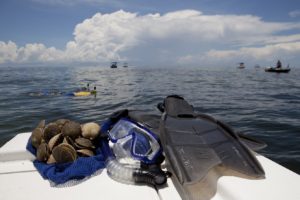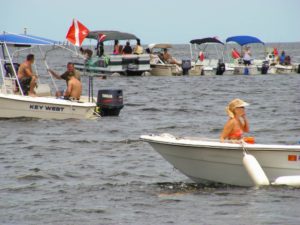The sections below will help you prepare for your scalloping adventure!
Gather Personal Equipment
- snorkel gear (mask, snorkel, fins)
- mesh bag and/or dip net to harvest scallops
- plenty of water
- hat and sunscreen
- 1-3mm wetsuit (if you tend to get cold)
- sun suit or shirt
- gloves (optional)

Check License and Regulations
Anyone harvesting scallops needs a current Florida recreational saltwater fishing license, unless you are scalloping on a chartered trip. A saltwater fishing license can be obtained online from the FWC.
Make sure you understand the open seasons and bay scallop harvesting regulations. FWC manages the fishery by opening certain zones along the Big Bend to scalloping at different times. This makes the rules more complicated for scallopers, so be sure you understand the open and closed seasons and areas. Check FWC’s website for the most up-to-date information on open dates and zones.
A brief summary of basic rules is provided below (current as of Feb 2021).
Daily Bag Limit: 2 gallons of whole bay scallops in shell or 1 pint of bay scallop meat per person; Maximum of 10 gallons of whole bay scallops in shell, or 1/2 gallon bay scallop meat (4 pints) per vessel. These rules apply in all zones and seasons except in the Fenholloway to Suwannee zone (yellow shaded zone in FWC’s map) where the bag limit is lowered to 1/2 of the per person and vessel limit from June 15 to 30.
Minimum Size Limit: None, though it is recommended that you toss back scallops smaller than 2 inches across (the size of the bottom of a soda can or smaller).
Gear requirements: Scallops may only be landed by hand or by using a dip net, no other harvest methods are allowed.
Transit through closed areas: In past years, it was illegal to land or possess scallops outside open harvest areas. Starting in 2019, it became legal to directly transit through closed areas with legally harvested bay scallops on board. This means that you can harvest scallops from open areas and return directly to a boat access point in a closed area without stopping. You may not stop and fish for other species, for example, if you have scallops on board within a closed area. See the FWC’s regulations page for more, including details about GPS coordinates for harvest lines.
Pack Boating Safety Gear
Be sure to pack your divers down flag and familiarize yourself with the rules for displaying the flag. One of the most common divers down flag violations is displaying the flag while underway. Always remember to stow your flag before moving to a new location!
Also, check your standard boating safety equipment to be sure you have enough life jackets for every person aboard, a throwable flotation device, a sound-producing device such as a whistle or air horn, and a supply of visual distress signals in good condition (not wet or expired).
Finally, you’ll want a cooler with plenty of ice to keep scallops cool and safe to eat.

Next, head over to our sustainable scalloping page to learn how you can protect our fishery resources during your trip.
